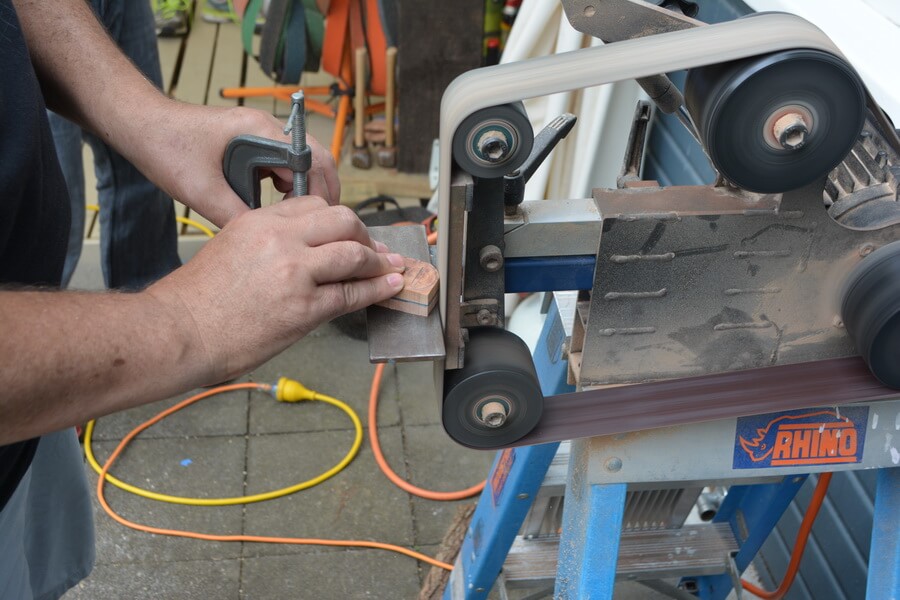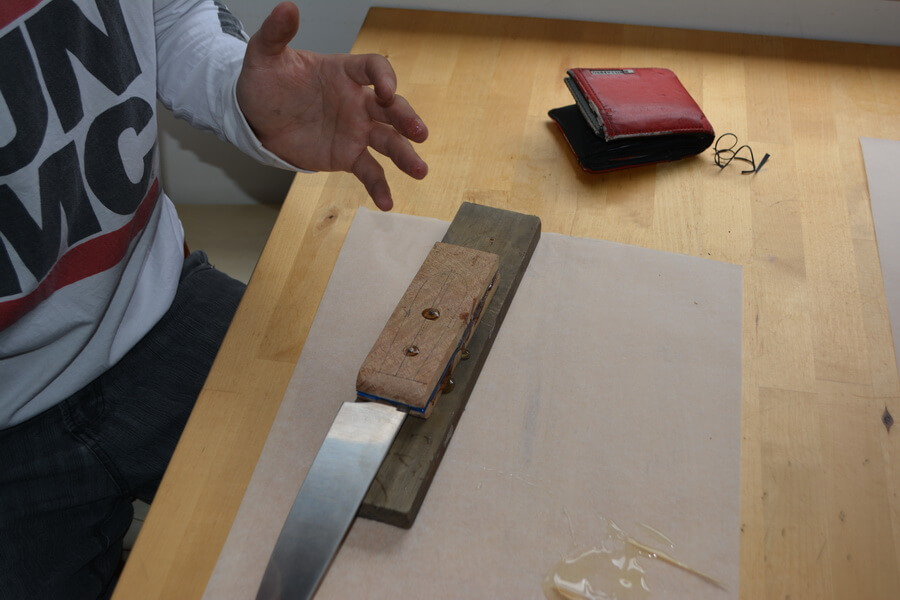Description
How to: Completing a Fulltang knife
These instructions are for Fulltang blades, where handle scales are attached on each side of the blade.
For stick tang instructions, see this link: https://nordicedge.com.au/how-to-completing-a-scandi-knife-kit/

This is a rather lengthy article, for those wanting a bit of detail.
The short version is simple:
- glue fibre spacer material to the handle scales
- drill holes in scales for pins (optional step)
- glue scales and pins to blade
- grind/file scales to profile of blade
- shape handle, rounding the scales by file or belt sander
- hand sand with sand paper
- seal handle with oil (optional step)
Step 1: Cut spacer material to size of handle scales, make sure scales are flat. Often wooden scales are not quite flat, and need to be sanded or touched to a belt sander to become flat. The vulcanised fibre spacer material is optional, but recommended. It helps fill any gaps, having a slight amount of give in it. It also gives a clean, crisp contrast line between the steel and handle material. Wrap blade with tape, ro in cardboard to protect the blade from the belt sander, and fingers from the blade.

Step 2: Glue the spacer material to the handle material. 5 min epoxy and some baking paper is handy for this, clamp the scales to a table or similar. Gluing the spacer material to the scales is a lot simpler than having lots of moving parts when gluing everything together, as well as simplifies drilling holes for pins or corby bolts if using these.

Step 3: Shape the front of the handle scales. It is much easier to clamp the scales to each other and shape the front bit before they are attached to the blade. Round them or square them, or whatever shape you prefer. The point is to make them symmetrical and help the later shaping by completing this side before gluing it all up. Lay the scales on the blade, decide where they will end and how the front should look. Using a coin or other round object is a simple way to get a round shape. Draw this on one scale and then shape them using a file, belt sander or similar.

Using a grinder to shape the front of the scales. Scales are clamped together to shape both scales at the same time and make it symmetrical. This could just as easily have been done by clamping the scales to a table and using a rasp or file.

Steo 4: Drill holes for handle pins (optional step). Lay the scales underneath the blade and drill through where the corby bolts or handle pins will be. Note the steel/brass/copper pins are much simpler to use than the corby bolts, only requiring a hole and glue to use. The corby bolts need a more precise process to give a good fit.
On this particular blade the holes are quite large and were just drawn on the handle scales, then holes drilled at the centre of the marking holes. Using 1/8" pins, drill 1/8" holes. Here are stainless steel pins in 416 steel used, these are freely machinable and take a great finish but in reality anything can be used. A nail, piece of coat hanger or welding rod etc all will work, just avoid hardened steel unless thoroughly enjoying hand sanding.

Optional step if using pins: Measure the handle pin lengths required and cut these with a hacksaw, dremel or the corner of a file. To make sure the wooden scales do not split, often the length of pin is lightly touched on a belt grinder before cutting to make it an easier fit. As always, do not use a dremel without protective glasses. Those little cutting discs fracture the second sideways pressure is applied to them.

Step 5: Ready for gluing. Wipe all sides that will have glue with acetone to prepare for the gluing. Be ready with kitchen paper and more acetone for wiping glue off the blade. This is easier than waiting for it to harden and then use something softer than steel to scrape it off.

A simple build like this works well with 5-min epoxy. Spread glue on the bottom scale, add the blade and then glue to the blade and then the last scale. Then add some glue to the pins and insert these. Have a hammer and board within reach if needing to tap the pins through. Then clamp it all up and wait for it to completely dry.

This is another reason why it is so great to us handle pins: Note how the scales line up automatically. Without the handle pins, the scales can slide around on the glue and be hard to line up. Then when adding clamps, they again slide around. Handle pins not only look good but help getting everything lined up.

Step 6: Shape the scales to the profile of the knife tang. This can be done by clamping the blade to a table, in a vice or similar and then filing or rasping the scales to the handle shape.
Here Geoff is using a belt sander to quickly grind away the excess handle scale material. The idea is to grind away all the wooden scale material that sticks out over the tang, until there is solid steel the entire way around.

Step 7: Shape the handle. This can be done on a belt sander, grinder, a floor sander upside down in your lap, by wood rasp or even by whittling it to shape. Anyway you prefer to remove material. The general idea is to round the scales until comfortable to hold. Some prefer the handle to thin towards the end, others prefer the end of the handle to be thicker and thin the fornt piece. There is no right or wrong, only what feels right to you.
Some design guide lines: mark 5 mm or so all around the handle scales. Try to not grind any further down than this, and even 5 mm is probably a bit too thin. Stop often, spend more time looking at the handle than grinding it. Take breaks, have another couple of knives nearby and compare the handle sizes. How wide across the back do you like the handle to be? How tapered do you want the front? It is easy to take off material, harder to add back so take your time and have fun.

Step 8: Hand sand the handle. Clamp the covered blade to a table or similar. Cut strips of sand paper, cover the back of the sand paper with a layer or two of masking tape. This way the sand paper does not break while "shoe shining". Sand by grabbing the strip of sand paper between your thumbs and fore fingers and shoe shine across the side of the knife handle that is up. This motion evens out the handle, smoothing out cuts from the belt sander. Start with 180 grit sand paper and keep going until there are no scratches going any other way than the way you are sanding. This is pretty important and where it can be easy to give up.
Expect to spend more time on the first grit than the other grits combined, as you need to get the scratches out. If there are deep gushes, even go to 80 grit paper but be careful of how long you do this, as even 180 grit paper will remove quite a bit of wood in a minute of sanding.
You are looking for fine, white lines. These are scratches that the wood dust are gathering in and may not be very visible when the entire handle is at the same, coarse grit. But as the rest of the handle becomes shiny at the higher grits of sand paper, the scratch will be more and more visible as the contrast increases. There is no real way to get it out when you get to 800 grit paper and you may have to go back to the 180..
Let it take the time it will take, ending with an even, rounded handle. Do one side with one grit, then turn the knife over and do the other side with the same grit. Before leaving that grit, do the sides, unless you want the sharp ridge that is being created on the top and bottom of the handle.
Grits to use can for example be 180, 320 or 400, 600, 800, 1200 (all of these are often available at hardware stores like Bunnings. If wanting a real nice finish, get some high grit sand paper from ebay or similar. We often go to 3,000 grit. 1200 would be a minimum as this is where the wood grain starts to really pop out.

Hand sanding with a fairly coarse sand paper also shapes the handle, so it can be good to stop a little early and then smooth the shape with some shoe shining

The finished product! Australian Red Mallee Burl handle scales, sanded to 3,000 grit.

Another finished handle sanded to 3,000 grit. This one is in mango wood.

Optional step: Seal the handle with oil, wax or similar to protect it from moisture and retain the finish. This can be Danish/scandinavian oil for furniture, CCL oil specifically made for knife handles, tung oil, or similar. This is the mango wood handle finished with CCL oil, a great handle finish that dries hard and clear.















